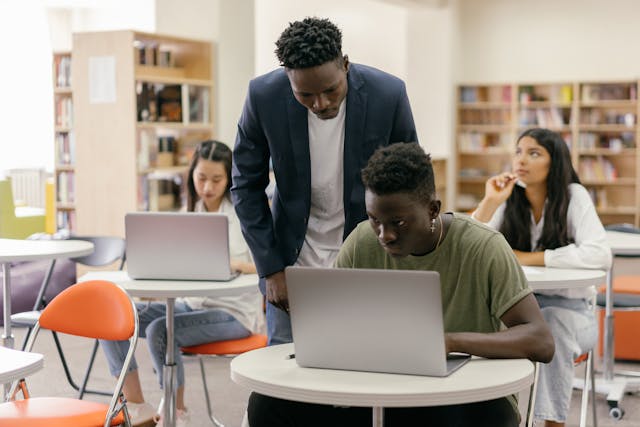If you’re not aware of how technology has fundamentally transformed education on a global scale, just picture a classroom from 25 years ago. From how students access information to how educators deliver lessons, digital tools have reshaped every aspect of learning. They drive engagement, facilitate personalized learning, and equip students with skills essential for a tech-driven world.
For educators, staying informed about the latest advancements in educational technology is no longer optional; it is an essential part of modern teaching. As technology evolves, so do the tools and strategies that effectively prepare students for future challenges. By embracing this transformation, educators give every student opportunities to succeed.
Thinking about the future, we know that the educational landscape will evolve even further in the coming years. In this ever-changing world, we encourage educators to hop on board, hold on tight, and keep an open, inquisitive mind.
Top Classroom Technologies Educators Should Know
Educational technology in 2025 will focus on personalization, engagement, and inclusivity. Artificial intelligence (AI) will lead the way with adaptive learning platforms that customize content to suit individual student needs. Virtual and augmented reality (VR/AR) will create immersive experiences, making complex topics relatable and enjoyable.
Gamification continues to motivate learners by turning lessons into interactive challenges, while hybrid learning combines digital tools with traditional classrooms, offering greater flexibility. Innovations also prioritize accessibility. Assistive technologies are advancing to support diverse learners and promote equitable access to education.
The top classroom technologies empower educators to create dynamic environments encourage creativity, collaboration, and curiosity. These are just a few examples:
- Interactive smartboards enable teachers to present lessons visually with computer screens and projectors.
- VR platforms offer immersive experiences that transport students to different places (like museums) and times using headsets.
- Adaptive learning software, which adjusts content based on a student’s performance, is another powerful tool. Students receive instruction tailored to their unique pace and abilities, promoting deeper comprehension.
- Gamification platforms are especially effective; over 90% of children in this country regularly play video games. Not surprisingly, classroom gaming tools motivate students more than any other method of teaching.

Visual Learning with Flowcharts
Visual aids have long been a cornerstone of effective teaching, and flowcharts are among the most versatile tools available. They simplify complex ideas, making them easier for students to understand. By visually mapping out processes, concepts, or relationships, flowcharts help students see the “big picture” while breaking down topics into manageable parts.
- Science class flowcharts can illustrate the steps of photosynthesis or the water cycle.
- History class flowcharts can map out key events and their interconnected causes and effects.
- Math lessons can also benefit from flowcharts that show the steps of solving equations or tackling word problems.
Educators can incorporate flowchart software into collaborative, custom projects. These tools import data, effortlessly build professional diagrams, and allow students to work together in real time. By encouraging students to create their own flowcharts, teachers can promote critical thinking and bring ideas to life.
Shaping Tech-Focused Policies in Education
The adoption of technology in education must go beyond individual classrooms — it requires systemic change supported by well-designed policies. Educators play critical roles in advocating for policies and strategies that promote equitable access to technology for all students. Without these measures, the digital divide can widen, leaving some students without the resources they need to succeed in a tech-driven world.
Advanced degrees in education equip teachers with the skills needed to influence these changes. Educators with these qualifications can create curricula that effectively integrate technology, serving all students regardless of their backgrounds.
For instance, a Master of Education degree prepares teachers for leadership roles in education policy, curriculum development, and shaping the future of AI in education. Educators can contribute to a more equitable, inclusive educational system by earning advanced degrees.
Strategies for Seamless Integration of Technology
Incorporating technology into classrooms requires thoughtful planning and strategic implementation:
- Training teachers is the first and most important step in ensuring that digital tools are used effectively. Professional development programs focused on technology help educators become confident in using new tools and integrating them into their teaching.
- Balancing traditional teaching methods with digital innovations is equally important. While technology offers tremendous benefits, not all students learn best through digital platforms. A blended approach that combines face-to-face instruction with online tools can accommodate diverse learning styles.
- Another key strategy is assessing the success of technology integration regularly. Educators can gather feedback from students, monitor activity levels, and analyze learning outcomes to determine what works and what needs improvement.
These insights enable teachers to refine their methods and maximize the impact of technology in their classrooms.
Overcoming Challenges of Tech Adoption in Education
While technology offers immense potential, its adoption in education comes with challenges that must be addressed. One of the most significant barriers is the digital divide, which refers to unequal access to technology and internet connectivity among students. Schools and policymakers must work together so that every student has access to the necessary tools for learning, regardless of their socioeconomic background.
By addressing these challenges head-on, educators can create a sustainable framework for integrating technology into education. The result is a more inclusive, engaging, and effective learning environment that prepares students for the future.

